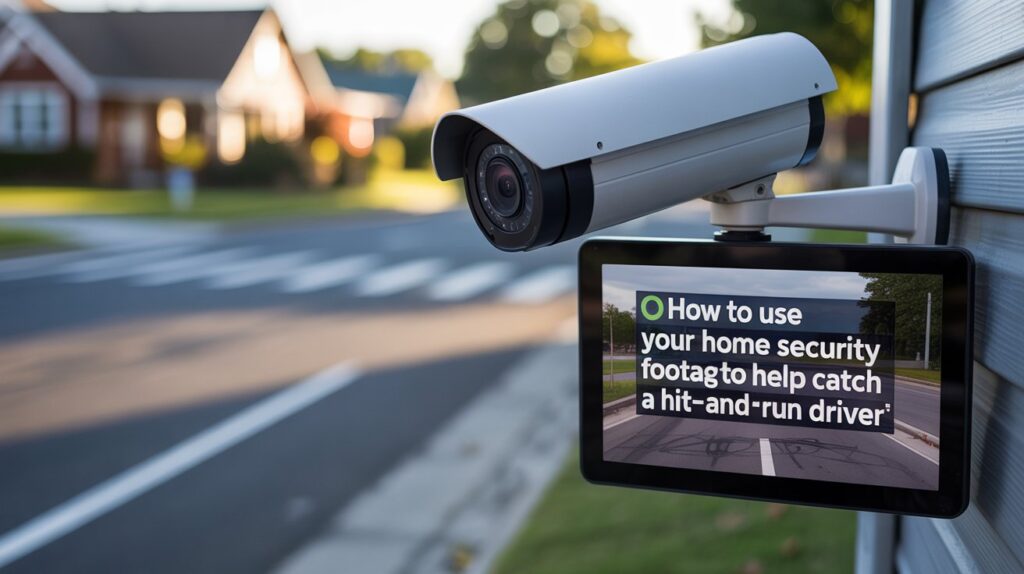Discovering your property damaged by a hit-and-run driver is a frustrating and common experience. According to data from Florida’s Department of Highway Safety and Motor Vehicles, otherwise known as the FLHSMV, there was a total of 104,273 hit-and-run crashes in Florida in 2023 alone, underscoring the prevalence of these incidents.
While you may feel powerless, a home security camera can provide critical evidence to help you find the person responsible. Learn the essential steps for handling your security footage to maximize its value for law enforcement.
Immediate Actions After Discovery
Before addressing your camera system, prioritize your safety and the integrity of the accident scene. Keep a safe distance if there are downed power lines or leaking fluids. Next, follow these steps:
- Contact Police: File an official police report immediately. This report is required for any insurance claim and is the first step in a criminal investigation.
- Document the Scene: Use a smartphone to take high-quality, high-resolution photos and videos of the damage from various angles, including wide shots and close-ups. This documentation is crucial for preserving the scene as it was found.
- Search for Witnesses: Ask neighbors if they saw or heard anything. Inquire whether they have any security cameras that may have captured the event from a different perspective. Many law enforcement agencies in Florida, such as the Clearwater Police Department, have voluntary camera registration programs to assist with investigations, providing an example of how citizens can partner with police.
- Do Not Touch Evidence: Avoid moving debris like broken plastic or paint chips. These items can be valuable forensic evidence for investigators.
Securing and Submitting Your Footage
Once the scene is secured, your next priority is properly handling the digital evidence from your camera. Do not simply screen-record the video from your phone; use your camera app’s native Download or Export function. This preserves the original file’s highest quality and essential metadata, like the exact time and date of the incident.
Save multiple copies of the file on a local device and a cloud storage service like Dropbox or Google Drive to ensure the evidence is not lost.
When providing the footage to law enforcement, follow their specific instructions. They may ask you to upload it to a secure portal, email a link, or bring a physical storage device to the station. Releasing the video on social media is not advised without police approval, as it could compromise the official investigation.
How to Assist the Investigation
After you submit your video evidence, investigators will use it as a primary tool to identify the suspect. Understanding what happens in a hit-and-run case from a legal and investigative standpoint is crucial. Your security footage provides the most valuable clues, helping police narrow their search and build a case. Police look for specific details in the footage that can lead to an identification.
Investigators use several key pieces of information from security footage to solve cases. The most valuable detail is a full or partial license plate number, which can directly identify the vehicle’s owner. Even if the license plate is not visible, a clear shot of the vehicle’s make, model, and color significantly narrows the search for authorities.
Other unique identifiers, such as dents, stickers, or roof racks, can also help confirm the suspect’s vehicle’s identity. Furthermore, noting the vehicle’s direction of travel helps police determine its likely path, allowing them to search for other cameras along that route. Finally, a precise timestamp on the footage is essential for establishing an official crime timeline.
According to data from the Florida Department of Highway Safety and Motor Vehicles (FLHSMV), over 80% of hit-and-run crashes involve property damage only. However, leaving the scene is a serious crime with severe penalties. In Florida, a hit-and-run with property damage is a second-degree misdemeanor. At the same time, a fatality can result in a first-degree felony with a mandatory minimum four-year prison sentence under Florida’s Aaron Cohen Life Protection Act. These penalties highlight why it is critical for law enforcement to successfully use all available evidence, like your security footage, to solve these cases.
When you speak to the investigating officer, be prepared to share specific details you observed in the video, such as:
- Date and Time: The precise moment of impact.
- Vehicle Description: Make, model, and color of the suspect’s vehicle.
- License Plate: Any readable letters or numbers.
- Direction: The vehicle’s path before and after the collision.
- Features/Damage: Any distinguishing marks on the car.
- Driver Description: If the driver is visible, provide a description.
Your Home Security System as an Investigative Tool
The modern home security camera system has evolved from a simple deterrent to an indispensable investigative tool. By following the meticulous steps of properly documenting the scene, securing your digital evidence, and delivering it to law enforcement in a usable format, you transform a feeling of helplessness into a proactive, meaningful action.
Your willingness to assist in the investigation by providing high-quality, verifiable video footage of what happens in a hit and run case significantly increases the chances of a case being solved. Law enforcement agencies in Florida and nationwide increasingly rely on these partnerships with residents to gather the crucial evidence needed to hold criminals accountable. The actionable information your camera captures-from a partial license plate to unique vehicle details-can be the key that unlocks the case.
Enhance Your Home’s Security for Future Peace of Mind
The range of proactive steps you can take to address a hit-and-run incident highlight the importance of being prepared. Now that you understand your cameras’ value in a legal context, it is a perfect time to evaluate your overall home security setup.
Ensuring your system is strategically placed to cover all high-risk areas, adequately maintained, and configured for optimal video quality can give you peace of mind and, should the need arise, provide the definitive evidence required to solve a crime.

